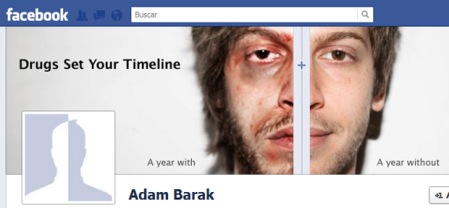I have a question for you…Are we breeding a generation of propagandist PR professionals?
Looking at many modern PR campaigns for change it’s obvious that many are utilising the shock tactic method as means to communicate their message. So has propaganda become the new persuasion when it comes to communicating tough truths?
Wilcox and Cameron (2006) quote Richard Perloff, “Persuasion is an activity or process in which a communicator attempts to induce a change in the belief, attitude, or behaviour of another person or group of persons through the transmission of a message in a context in which the persuadee has some degree of free choice.” However in reality there is a new wave of invasive campaigns that are eliminating this element of freewill.
I want to take an analytical look back to the root of this issue and find out whether what we’re being taught as young professionals is actually conditioning us to think in a more propagandist way. More importantly do these learnt methods stand up in today’s PR practice? Do they shape the shock tactics taken on by many ‘persuasive’ campaigns?
Persuasion as a Paradox
The work of James E. Grunig has shaped the way many think and learn about public relations and has furthered our understanding of the persuasion vs. propaganda paradox.
In his typography (Grunig and Hunt 2004) he stated that his two way symmetrical model as the most ethical way to communicate a message. The basis for this belief is to negotiate, resolve and promote mutual understanding between an organisation and its publics. Their typography was based on scientific persuasive communication, whereby the public are brought round to the organisations way of thinking using clever idea altering methods and cannot therefore be considered truly ethical can it? Habermas (1989) certainly doesn’t think so. He views persuasion as unethical due to the inequalities of interests between persuader and persuadee. Subsequent theories based on these models and the consequent study of excellence in public relations has shaped the way PR is studied ever since.
Many academics have expressed concern that the dominance of the Grunig Paradigm, the art of persuasive communication is slowly being pushed aside. Michael Pfau and Hua-Hsin Wan put it this way: “Grunig’s two-way symmetrical model has received a great deal of attention in public relations scholarship.” They went on to say “The search for an alternative to a persuasion-based model of public relations has intrigued academics” (Pfau and Wan 2006 p. 190).
Consequently many schools in the US are starting to broaden the curriculum away from the work of Grunig and focus on the more rhetoric disciplines such as the work of Aristotle and more recently Burke (1966), among others (Heath, 2001;Toth and Heath 1992). This leading to a transatlantic void in moral standing or in other words are we being conditioned to believe that the Grunig paradigm way of practicing PR is the only option since there are very few alternative models in play in the UK curriculum?
How does this influence PR 2.0?
Grunig’s two way symmetrical model may have had some foundation in the PR of yesteryear when a cleverly written press release was all that stood between a PR professional and their public, enabling them to negotiate that mutual understanding that Grunig described. Today we are in a different ball game with digital and experiential activities having far more influence on public opinion so the two way communication theory is made somewhat redundant thanks to the elimination of consumer choice to participate in the activity. Organisations are now able to bring their cause or product right to the consumer…whether they like it or not.
Let me show you some recent campaigns that utilise some of these tools:
LUSH
Recently Lush Cosmetics got tongues wagging during their latest anti-animal testing campaign which saw a performance artist subjected to ten hours of appalling treatment in the shop window of a high footfall area in London. Now to me this looks like a propagandist activity; using shock tactics to decipher a message to an unexpected public; who did not choose to opt in or have a fair representation from the other side of the argument.
Israel Anti-Drug Authority
Then there are those ‘persuasive’ campaigns that utilise that site that we all waste hours on, Facebook. The Israel Anti-Drug Authority used the addition of the timeline to their benefit by creating the ‘Drugs Set Your Timeline’ campaign, where two very different stories were told down each side of the timeline. Is this another example of clever utilisation of technology or just another way for organisations to get to the heart of the consumer without their consent?
It’s true that Grunig’s theories do saturate the taught PR market however I think as PR professionals we create our own ethical behaviour despite your learning’s in a classroom. In reality it’s unlikely that I’ll ever achieve complete mutual understanding with my public’s as Grunig described as our intentions are never going to be parallel. To create an effective campaign it’s necessary to rise above all the noise of the modern world and penetrate your audience and these days this means increasingly taking the campaign to them. However I think McNair (1996) summerised this as one citizen’s persuasion will always be another’s manipulation, one’s public relations another’s propaganda and that clear-cut distinctions can be drawn only with difficulty.” As ‘persuasion 2.0’ continues to innovate through online tools the ethical line will become even more blurred unless the same level of innovation is taken with industry wide guidelines and regulations.
What do you think of these sort of ‘shock tactic’ campaigns?
As consumers are we too used to seeing these sort of campaigns to the point where clever persuasion has little or no effect?
Nature vs. Nurture – what do you think influences your ethics more?
Sources
Burke, K. (1966) Language as symbolic action, Berkeley, University of California Press
Cameron G and Wilcox D (2006) Public Relations Strategies and Tactics 8th ed
Grunig, J. E., and Hunt, T. (1984) Managing Public Relations, New York: Holt, Rinehart and Winston
Habermas, J. (1989) The Structural Transformation of the Public Sphere, MIT Press, Massachusetts
Heath, R.L. (ed.) (2001) The Handbook of Public Relations, Thousand Oaks, California, Sage
McNair, B (2006) Performance in Politics and the Politics of Performance: Public Relations, the Public Sphere and Democracy. In Critical Perspectives in Public Relations ed. L’Etang J and Pieczka M
Pfau, M and Wan, H.H. (2006) Persuasion: An intrinsic function of public relations. in The Public Relations Digest. Pearson Education
Toth, E. L., and Heath, R. L. (eds) (1992) Rhetorical and Critical Approaches to Public Relations, Hillsdale, New Jersey, Lawrence Erlbaum Associates




I think with all the new technology around these days it is so easy for us to get separated from the real stories, especially for younger generations. We are often bombarded with information so much so that we tend to ignore most of it. When we think back to news stories that happened a month ago, the ones we seem to remember are the ones that are more shocking. I think these shock tactics are often necessary because it is easier for people to opt out of something they disagree with rather than opt in to something they may know nothing about. For example, donation of organs after you pass away. There are those that feel so passionate about donating that they make sure they do, there are also those that feel so passionate about not donating that they refuse to sign up. But what about those who probably don’t care what happens to their organs, and would happily give them up, but aren’t passionate enough to go through the process of allowing donation. Therefore there is strong argument, in my opinion, that this should be compulsory and those that feel passionately enough about keeping their own organs will happily go through the process to remove themselves from this. The same can be said for this Lush campaign. Those who do not agree, do not have to watch, they can walk away. But for those who didn’t know much about this and are fairly interested are more likely to stop and look. Yes, there is the argument that it doesn’t tell both sides of the story but I think in these days, no one is naive enough to believe the first thing they hear. However these types of campaigns will encourage people to conduct their own research and make an informed decision whereas if this kind of campaign wasn’t produced, people would go on with their every day lives without even thinking twice about it. In conclusion, I think shock tactics do work. Unless people are tied to a chair and forced to watch, there is always an option to ‘opt out’. In terms of “As consumers are we too used to seeing these sort of campaigns to the point where clever persuasion has little or no effect?” – I think this is where shock campaigns are even more necessary. As stated previously, we are bombarded with information at the moment and only remember things that we can personally relate to or that shock us to the core. In many ways its a sad truth, but a truth none the less. So long as there is no ‘force’ element and there is a way for people to ‘opt out’ I think these campaigns are ethical and are just highlighting certain points that people tend to overlook.
Thanks for your comment Steph, some really great points there. When you say ‘So long as there is no ‘force’ element and there is a way for people to ‘opt out’ I think these campaigns are ethical and are just highlighting certain points that people tend to overlook’ do you think the methods I highlighted (stunts in the street and Facebook) are a step to far or just a natural progression to rise above the noise? Also do you think that these sort of campaigns especially Facebook require a new set of ethical guidelines?
A really interesting post, especially as there is to my mind no obvious right or wrong answer to any of your questions. I think that shock tactics often do get through to the consumer when other tactics might fail, and hence it can be seen as an incredibly useful tool to PRs in getting their message/s across. However, I think you raise a valid point in asking at what stage do consumers become too used to seeing such campaigns. If shock tactics are used too often on consumers across various campaigns, will they become desensitised to the messages that are trying to be conveyed? While these tactics still work (and I think they really did for the two campaigns you used to illustrate your point) it is tempting to PRs to try and use this method more than is strictly necessary, therefore increasing the rate at which consumers will feel their sympathy reaching saturation point. I think brands like Red Bull (as the classic example) are leading the crowd in new ways to ‘shock’ consumers but incite positive emotions and, while this is by no means a new trend, is one that should be monitored with interest.
Thanks for your comment Jen, really interesting point you’ve made about ‘positive shock tactics’ I’ve never thought of it like that! It’s funny that the term ‘propaganda’ still has such negative connotations, maybe we are entering a new generation of ‘positive propaganda’ where the mechanisms of the campaign are the same but the intention behind them is to entertain like your example of Redbull.